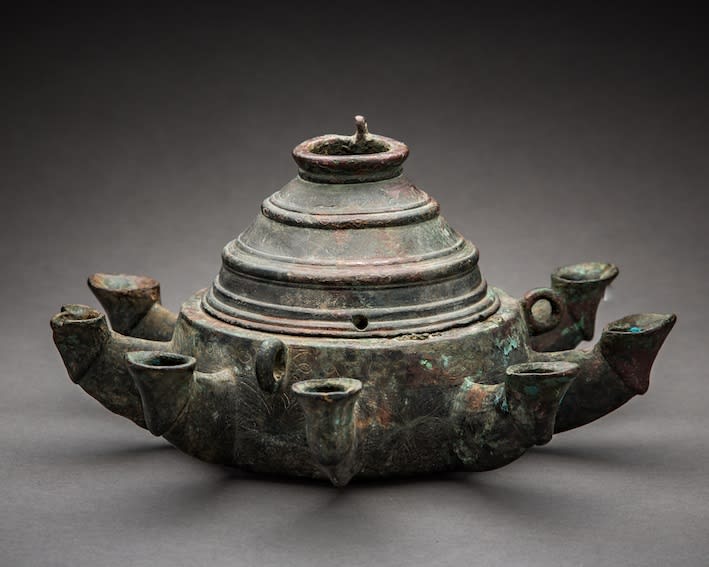Roman Bronze Oil Lamp, 100 CE - 300 CE
Bronze
13.3 x 26.7 cm
5 1/4 x 10 1/2 in
5 1/4 x 10 1/2 in
SF.048
An outstanding bronze lamp with eight spouts, in exceptional state of preservation. Due to the number of spouts, this was most probably a hanukkiah, the ritual candelabrum lit during the...
An outstanding bronze lamp with eight spouts, in exceptional state of preservation. Due to the number of spouts, this was most probably a hanukkiah, the ritual candelabrum lit during the eight-day Jewish holiday of Hanukkah. In a hanukkia, eight hold lights (candles or oil lamps), symbolising the eight nights of the holiday; on each night, one more light is lit than the previous night, until on the final night all eight branches are ignited. The ninth branch holds a candle, called the shamash ("helper" or "servant"), which is used to light the other eight. In this case the shamash was probably a separate small wick at the top, on the opening used also to fill the lamp. This is because to fulfil ritual requirements, the shamash must be offset on a higher or lower plane than the main eight lights.
Small bronze rings allowed the lamp to be suspended from a hook or from the ceiling with wires. The elegance of the rendering of the moulding seems to point out to a Classical period type, quite possibly reproduced during the middle imperial period.
A token of a faith already ancient when it was created, this lamp might have lit Jewish homes or temples centuries ago. A metaphor of joy and prosperity, for hope, for life itself, lamps have illuminated the path of civilization for centuries. They have guided great thoughts through the night, stood vigil with lonely passions. In the presence of this simple object, we are in touch directly with a vanished world, with the people once warmed by its glow. Today it remains as an enduring symbol of man's desire to conquer the darkness.
Small bronze rings allowed the lamp to be suspended from a hook or from the ceiling with wires. The elegance of the rendering of the moulding seems to point out to a Classical period type, quite possibly reproduced during the middle imperial period.
A token of a faith already ancient when it was created, this lamp might have lit Jewish homes or temples centuries ago. A metaphor of joy and prosperity, for hope, for life itself, lamps have illuminated the path of civilization for centuries. They have guided great thoughts through the night, stood vigil with lonely passions. In the presence of this simple object, we are in touch directly with a vanished world, with the people once warmed by its glow. Today it remains as an enduring symbol of man's desire to conquer the darkness.



